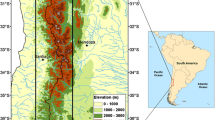Abstract
A five-member ensemble of regional climate model (RCM) simulations for Europe, with a high resolution nest over Germany, is analysed in a two-part paper: Part I (the current paper) presents the performance of the models for the control period, and Part II presents results for near future climate changes. Two different RCMs, CLM and WRF, were used to dynamically downscale simulations with the ECHAM5 and CCCma3 global climate models (GCMs), as well as the ERA40-reanalysis for validation purposes. Three realisations of ECHAM5 and one with CCCma3 were downscaled with CLM, and additionally one realisation of ECHAM5 with WRF. An approach of double nesting was used, first to an approximately 50 km resolution for entire Europe and then to a domain of approximately 7 km covering Germany and its near surroundings. Comparisons of the fine nest simulations are made to earlier high resolution simulations for the region with the RCM REMO for two ECHAM5 realisations. Biases from the GCMs are generally carried over to the RCMs, which can then reduce or worsen the biases. The bias of the coarse nest is carried over to the fine nest but does not change in amplitude, i.e. the fine nest does not add additional mean bias to the simulations. The spatial pattern of the wet bias over central Europe is similar for all CLM simulations, and leads to a stronger bias in the fine nest simulations compared to that of WRF and REMO. The wet bias in the CLM model is found to be due to a too frequent drizzle, but for higher intensities the distributions are well simulated with both CLM and WRF at the 50 and 7 km resolutions. Also the spatial distributions are close to high resolution gridded observations. The REMO model has low biases in the domain averages over Germany and no drizzle problem, but has a shift in the mean precipitation patterns and a strong overestimation of higher intensities. The GCMs perform well in simulating the intensity distribution of precipitation at their own resolution, but the RCMs add value to the distributions when compared to observations at the fine nest resolution.









Similar content being viewed by others
Notes
UBA (Umweltbundesamt) and BFG (Bundesanstalt für Gewässerkunde).
Center for Disaster Management and Risk Reduction Technology, http://www.cedim.de.
References
Argüeso D, Hidalgo-Muñoz JM, Gámiz-Fortis SR, Esteban-Parra MJ, Dudhia J, Castro-Díez Y (2011) Evaluation of WRF parameterizations for climate studies over Southern Spain using a multi-step regionalization. J Clim. doi:10.1175/JCLI-D-11-00276.1, in press
Awan NK, Truhetz H, Gobiet A (2011) Parameterization induced error-characteristics of MM5 and WRF operated in climate mode over the Alpine Region: an ensemble based analysis. J Clim 24:3107–3123
Berg P, Feldmann H, Panitz H-J (2012) Bias correction of high resolution regional climate model data, J Hydrol, online first, doi:10.1016/j.jhydrol.2012.04.026
Boberg F, Berg P, Thejll P, Gutowski WJ, Christensen JH (2009) Improved confidence in climate change projections of precipitation evaluated using daily statistics from the PRUDENCE ensemble. Clim Dyn 32(7–8):1097–1106. doi:10.1007/s00382-008-0446-y
Boberg F, Berg P, Thejll P, Gutowski W, Christensen J (2010) Improved confidence in climate change projections of precipitation further evaluated using daily statistics from ENSEMBLES models. Clim Dyn 35(7–8):1509–1520, doi:10.1007/s00382-009-0683-8
Borge R, Alexandrov V, Josédel Vas J, Lumbreras J, Rodríguez E (2008) A comprehensive sensitivity analysis of the WRF model for air quality applications over the Iberian Peninsula. Atmos Environ 42(37):8560–8574
Chen F, Dudhia J (2001) Coupling an advanced land-surface hydrology model with the PennState NCAR MM5 modeling system. Part I: model description and implementation. Mon Weather Rev 129:569–585
Christensen JH, Christensen OB (2007) A summary of the PRUDENCE model projections of changes in European climate by the end of this century. Clim Change 81:7–30. doi:10.1007/s10584-006-9210-7
Christensen JH, Kjellström E, Giorgi F, Lenderink G, Rummukainen M (2010) Weight assignment in regional climate models. Clim Res 44:179–194
Doms G, Schättler U (2002) A description of the nonhydrostatic regional model LM, Part I: dynamics and numerics. COSMO Newsl 2:225–235
Done J, Davis C A, Weisman M (2004) The next generation of NWP: explicit forecasts of convection using the weather research and forecasting (WRF) model. Atmos Sci Let 5:110–117
Dudhia J (1989) Numerical study of convection observed during the winter monsoon experiment using a mesoscale two-dimensional model. J Atmos Sci 46:3077–3107
Feldmann H, Früh B, Schädler G, Panitz HJ, Keuler K, Jacob D, Lorenz P (2008) Evaluation of the precipitation for South-western Germany from high resolution simulations with regional climate models. Meteorol Z 17:455–465
Feldmann H, Früh B, Kottmeier Ch, Panitz H-J, Schädler G (2010) Hochauflösende regionale Simulationen künftiger Starkniederschalgsereignisse in Baden-Württemberg (ReSiPrec). Technical Report, IMK-TRO, KIT
Fowle MA, Roebber PJ (2003) Short-range (0–48 h) numerical prediction of convective occurence, mode, and location. Weather Forecast 18:782–794
Frei C, Christensen JH, Dequé M, Jacob D, Jones RG, Vidale PL (2003) Daily precipitation statistics in regional climate models: evaluation and intercomparison for the European Alps. J Geophys Res 108:4124–4143. doi:10.1029/2002JD002287
Giorgi F (2006) Regional climate modeling: status and perspectives. J Phys IV France 139:101–118. doi:10.1051/jp4:2006139008
Haylock M, Hofstra N, Tank AMGK, Klok EJ, Jones PD, New M (2008) A European daily high-resolution gridded dataset of surface temperature, precipitation and sea-level pressure. J. Geophys. Res. 113:D20,119.1–D20,119.12. doi:10.1029/2008JD010201
Hewitt CD (2005) The ENSEMBLES project: providing ensemble-based predictions of climate changes and their impacts. EGGS Newsl 13:22–25
Hofstra N, Mew M, McSweeney C (2010) The influence of interpolation and station network density on the distributions and trends of climate variables in gridded daily data. Clim Dyn 35:841–858. doi:10.1007/s00382-009-0698-1
Hong SY, Lim JOJ (2006) The WRF single-moment 6-class microphysics scheme (WSM6). J Korean Meteor Soc 42:129–151
Hong SY, Dudhia J, Chen SH (2004) A revised approach to ice microphysical processes for the bulk parameterization of clouds and precipitation. Mon Weather Rev 132:103–120
Hong SY, Noh Y, Dudhia J (2006) A new vertical diffusion package with an explicit treatment of entrainment processes. Mon Weather Rev 134:2318–2341
Jacob D, Vanden Hurk BJJM, Andrae U, Elgered G, Fortelius C, Graham LP, Jackson SD, Karstens U, Köpken C, Lindau R, Podzun R, Rockel B, Rubel F, Sass BH, Smith RNB, Yang X (2001) A comprehensive model inter-comparison study investigating the water budget during the baltex-pidcap period. Meteorol Atmos Phys 77:19–43. doi:10.1007/s007030170015
Jacob D, Göttel H, Kotlarski S, Lorenz P, Sieck K (2007) Klimaauswirkungen und Anpassung in Deutschland—phase 1: Erstellung regionaler Klimaszenarien fur Deutschland. Technical report, Umweltbundesamt
Jacob D, Bärring L, Christensen O B, Christensen J, de Castro M, Déqué M, Giorgi F, Hagemann S, Hirschi M, Jones R, Kjellström E, Lenderink G, Rockel B, Sánchez E, Schär C, Seneviratne S, Somot S, van Ulden A, van den Hurk B (2007) An inter-comparison of regional climate models for Europe: model performance in present-day climate. Clim Change 81:31–52. doi:10.1007/s10584-006-9213-4
Kain JS (2004) The Kain-Fritsch convective parameterization: an update. J Appl Meteor 43:170–181
Kotlarski S, Block A, Boehm U, Jacob D, Keuler K, Knoche R, Rechid D, Walter A (2005) Regional climate model simulations as input for hydrological applications: evaluation of uncertainties. Adv Geosci 5:119–125
Mitchell TD, Jones PD (2005) An improved method of constructing a database of monthly climate observations and associated high-resolution grids. Int J Climatol 25:693–712. doi:10.1002/joc.1181
Mlawer EJ, Taubman SJ, Brown PD, Iacono MJ, Clough SA (1997) Radiative transfer for inhomogeneous atmosphere: RRTM, a validated correlated-k model for the longwave. J Geophys Res 102:16663–16682
Morcrette J-J, Smith L, Fourquart Y (1986) Pressure and temperature dependance of the absorption in longwave radiation parameterizations. Beitr Phys Atmos 59:455–469
Nordeng TE (1994) Extended versions of the convective parametrization scheme at ECMWF and their impact on the mean and transient activity of the model in the tropics. ECMWF Research Department, Technical Momorandum no. 206, October 1994, European Centre for Medium Range Weather Forecasts, Reading, UK
R Development Core Team (2011) R: a language and environment for statistical computing. R Foundation for Statistical Computing, Vienna, Austria, URL http://www.R-project.org/, ISBN 3-900051-07-0
Reichler T, Kim J (2008) How well do coupled models simulate today’s climate? BAMS, March, 303–311
Ritter B, Geleyn JF (1992) A comprehensive radiation scheme for numerical weather prediction models with potential applications in climate simulations. Mon Weather Rev 120:303–325
Roeckner G (2006) IPCC-AR4 MPI-ECHAM5_T63L31 MPI-OM_GR1.5L40 20C3M run no.1: atmosphere 6 HOUR values. Technical report, MPImet/MAD Germany, doi:10.1594/WDCC/EH5-T63L31_OM-GR1.5L40_20C_1_6H
Roeckner G, Baeuml G, Bonaventura L, Brokopf R, Esch M, Giorgetta M, Hagemann S, Kirchner I, Kornblueh L, Manzini E, Rhodin A, Schlese U, Schulzweida U, Tompkins A (2003) The atmospheric general circulation model ECHAM 5. PART I: model description. Technical report, MPImet/MAD Germany
Schädler G, Berg P, Düthmann D, Feldmann H, Ihringer J, Kunstmann H, Liebert J, Merz B, Ott I, Wagner S (2012) Flood hazard in a changing climate. Technical report, CEDIM-report, Karlsruhe, URL http://www.cedim.de/download/Flood_Hazards_in_a_Changing_Climate.pdf
Schwitalla T, Bauer HS, Wulfmeyer V, Aoshima F (2011) High-resolution simulation over central Europe: assimilation experiments during COPS IOP 9c. Q J R Meteorol Soc 137(S1):156–175
Scinocca JF, McFarlane NA, Lazare M, Li J, Plummer D (2008) The CCCma third generation AGCM and its extension into the middle atmosphere. Atmos Chem Phys 8:7055–7074
Skamarock WC, Klemp JB, Dudhia J, Gill DO, Barker DM, Duda MG, Huang X, Wang W, Powers JG (2008) A description of the advanced research WRF version 3. Technical Report 459, NCAR, Boulder, Colorado, USA
Smiatek G, Kunstmann H, Knoche R, Marx A (2009) Precipitation and temperature statistics in high-resolution regional climate models: evaluation for the European Alps. J Geophys Res 114:16. doi:10.1029/2008JD011353
Sundquist H (1978) A parameterization scheme for non-convective condensation including precipitation including prediction of cloud water content. Q J R Meteorol Soc 104:677–690
Taylor KE (2001) Summarizing multiple aspects of model performance in a single diagram. J Geophys Res 106:7183–7192
Tiedtke M (1989) A comprehensive mass flux scheme for cumulus parameterization in largescale models. Mon Weather Rev 117:1779–1800
Wagner S, Berg P, Schädler G, Kunstmann H (2011) High resolution regional climate model simulations for Germany: Part II—projected climate changes. Clim Dyn. doi:10.1007/s00382-012-1510-1
Will A, Woldt M (2009) Comparison of COSMO-CLM results with CM-SAF products: radiation components ToA, at the surface and cloud properties Technical Report IOP VS Study 16, Climate Monitoring Satellite Application Facility (CMSAF) at DWD, Offenbach, p 121
Acknowledgments
The authors acknowledge funding from the CEDIM-project “Flood hazard in a changing climate”. The RCM simulations were carried out at HLRS at the University of Stuttgart within the project “High resolution climate modelling” (HRCM) for CLM and within the project “High resolution regional climate modeling for Germany using WRF” for WRF. We would also extend a great thank you to the CLM and WRF-modeling communities, particularly H.-J. Panitz and J. Werhahn from IMK for help with the RCM simulations. The REMO simulation data was downloaded from the CERA online archive, and our appreciation also to the REMO modeling group at MPI-M in Hamburg. We also appreciate the work of the ECA&D group for the work on the E-OBS data set, and to the German Weather Service (DWD) for the REGNIE data set and the DWD/PIK data set (along with the Potsdam Institut für Klimafolgenforschung). Finally, we would like to acknowledge the work of the R Development Core Team (2011), the developers of CDO, and thank the anonymous reviewers for valuable feedback.
Author information
Authors and Affiliations
Corresponding author
Rights and permissions
About this article
Cite this article
Berg, P., Wagner, S., Kunstmann, H. et al. High resolution regional climate model simulations for Germany: part I—validation. Clim Dyn 40, 401–414 (2013). https://doi.org/10.1007/s00382-012-1508-8
Received:
Accepted:
Published:
Issue Date:
DOI: https://doi.org/10.1007/s00382-012-1508-8




